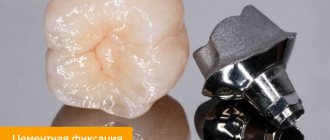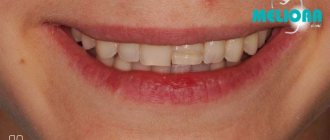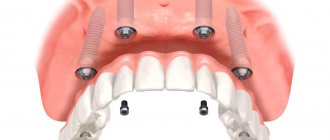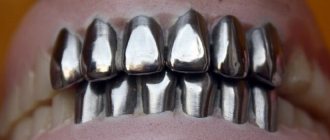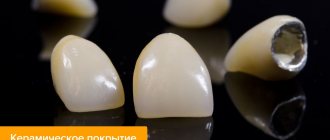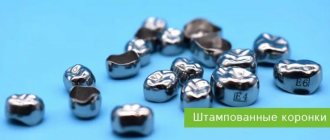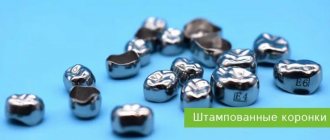High-quality complete dental prosthetics with crowns in Moscow implies not only the restoration of their chewing function. Teeth are the most important component of a beautiful, attractive smile that evokes the sympathy and trust of others. Therefore, both affordable metal-ceramic crowns and more expensive aesthetic crowns should fit perfectly into the dentition and serve for a long time without causing undesirable consequences. Modern medicine has all the materials and technologies necessary for this.
Filling or crown: which option to choose?
The crown of a tooth refers to both its part located above the gum mucosa and an artificial structure in the form of a case, put on the natural crown destroyed by caries. The need for such tooth restoration arises after treatment of deep caries and pulpitis with the passage of root canals, and sometimes after mechanical trauma to the jaw and tooth.
Many patients are afraid of having a crown installed and beg the dentist to limit themselves to a filling. But if you fill a pulpless tooth, of which less than 50% of its own tissue remains, then it will most likely have to be removed very soon. After all, hard tissues after removing the pulp become very fragile and easily crack under load. Prosthetics after removal will become inevitable, but will cost much more.
Indications and contraindications
Installation of combined products is indicated in the following cases:
- the crown part of the tooth is severely damaged and cannot be restored by other methods (approximately two-thirds of the tissue must be removed);
- increased abrasion, the lower third of the face is characterized by a decrease in height, that is, the normal contours are distorted;
- the color of the enamel has been changed, the process is irreversible and other restoration options will not be effective;
- mobility of individual units of the row is observed (such crowns are used as splinting, strengthening devices);
- partial edentia, in which the use of bridge structures is recommended;
- for implantation;
- as a reliable support for fixing orthodontic appliances;
- when replacing old dentures that are damaged or worn out.
Combined products are not installed in the following situations:
- the wall of a natural tooth is thinned, weakened and will not withstand additional load;
- risks of serious pulp damage during turning;
- the need to restore lower anterior teeth;
- deep bite, accompanied by protrusion of the upper incisors;
- age restrictions (such systems are not used until 16-18 years old);
- bruxism.
Why do they grind down a tooth for a crown?
The dentist must remove part of the tissue to form a stump of a certain shape:
- a ledge is formed at the edge of the gum, on which the crown will be placed in the future;
- The edges of the tooth should remain almost parallel, and not cone towards the chewing edge.
The service life of the artificial crown largely depends on the quality of preparation and compliance with these two conditions. If there is no smooth and even ledge, its edge will not adhere to the tooth, but will hang over the gum, forming a gap. Soft plaque will accumulate around, and colonies of pathogenic microflora developing in it will cause caries and gum inflammation.
If the tooth stump takes a cone-shaped shape after filing, it will be difficult for the dental technician to produce a functional structure that can withstand the chewing load. This is fraught with depressurization (or decementing) of the crown. Residues of food and soft plaque with microflora will penetrate under it, which will eventually lead to its loss.
Preparation for the crown of a living, non-pulpless tooth should be carried out with plenty of cooling. After all, overheating of the tissues will cause inflammation of the pulp, which may appear after the installation of the crown. Due to the need to treat pulpitis, it will have to be removed and redone after treatment of the canals.
All the pros and cons
Combined crowns are an economical solution to the problem of functionality and aesthetics of the dentition. Expensive metal-free structures made of zirconium oxide can ensure the strength and attractiveness of teeth.
All-ceramic products are installed on the frontal zone. Due to their low strength, such dentures are not suitable for fixation on chewing elements. The cost of this model is higher than that of the combined ones.
Varieties
The market offers three types of microprostheses: metal-composite, metal-ceramic and metal-plastic. The base production technology is the same. The difference lies in the cladding.
Metal-plastic
Metal microprostheses with an outer layer of polymethacrylate. Cladding material is available in different forms. Various technologies for applying external coating are used.
Plastic does not enter into a chemical bond with metal. Special liquids can increase the adhesion force. This eliminates the need for retention.
Production technology:
- After the casting or stamping procedure is completed, the frame is sandblasted and degreased.
- Modeling a plastic crown with wax on a plaster model of the unit, made from an impression.
- Packing the model into molding mass, removing wax during heating.
- Filling the cavity with plastic under pressure.
It is possible to use other methods of applying the composition. For example, layer-by-layer application of a polymer composition with a brush (spatula). Each layer is polymerized.
The technology for applying the composition is determined by the original form. Polymer coating is supplied in powder and liquid form. The components are mixed immediately before use in certain proportions.
According to the curing method, the material can be cold or hot polymerization.
Metal-ceramic
The cladding is glass ceramics. The starting material is ceramic powder diluted in liquid. The material is applied layer by layer with each layer being fired in an oven. After processing, the product is fitted to the tooth, refined and glazed.
Durable microprostheses are suitable for installation in the chewing and frontal areas. They are distinguished by aesthetics, functionality and durability. Disadvantage - the thickness of the crown in some places reaches 2 mm.
Metal composite
Composite mass is a hybrid composition consisting of organic resins and tiny ceramic particles. The composition is applied to the base and polymerized with a lamp. The pros and cons of a composite are determined by the specific material. The products are inferior in quality to ceramic structures. It is possible to repair metal-composite dentures in the patient’s mouth if there are clinical indications.
Step-by-step installation algorithm
Manufacturing and fastening of a metal-ceramic structure with a solid base includes the following steps:
- Inspection and diagnostics.
- Product selection.
- Turning of the support element.
- Production of microprosthesis.
- Making impressions and casting the frame.
- Fitting the base to the unit.
- Determining the shade of artificial enamel.
- Sintering of the ceramic layer.
- Fitting, correction.
- Glazing, final processing.
- Fastening to the element using cement.
How to take impressions correctly?
If the mucous membrane was damaged when grinding the native crown, the procedure for taking impressions should be postponed until it is restored.
- In some patients, the injured gum can give recession - move away from the neck of the tooth and expose its root.
- Due to the presence of blood, the materials used to obtain impressions may not clearly depict the formed ledge.
As a result, the edge of the manufactured and installed crown will stick out above the gum, which will significantly reduce the aesthetics of prosthetic treatment of the front teeth.
Advantages and disadvantages
Combined models are an economical solution for row restoration. They retain functionality, provide the aesthetics of the range, and are relatively inexpensive. Various materials are used for manufacturing; the best solutions are ceramics and metal-free ones using zirconium oxide. Installation is simple, quick, and the service life of such crowns is up to fifteen years. In this case, the tooth is preserved; only turning is needed for installation. There are not many disadvantages, they depend on the materials used.
Signs of high-quality preparation for metal-ceramics
The result of correct preparation for a stamped or cast crown must meet the following criteria:
To get detailed advice on treatment, preparation and prosthetics of teeth, sign up for a consultation at Aristocrat-Dent dentistry.
You can make an appointment by calling 8 (495) 638-05-05. Consultation is free if treatment is started on the day of treatment.
Is it possible or not?
Combined type crowns are placed on any teeth. Most often on those located in the smile zone - frontal maxillary, upper premolars. If the client wishes, it is possible to cover the molars, but it will not be advisable to sharpen the supporting teeth too much.
It is recommended to install combined speakers in the following cases:
- destruction of more than 70% of the tooth volume;
- decreased height of the lower part of the face due to tooth wear;
- irreversible change in enamel shade;
- severe tooth mobility;
- complete or partial absence of teeth for various reasons;
- implantation;
- replacing old crowns;
- placing medications in the tooth;
- production of supports for special devices.
Stages of installing a metal-ceramic crown
Prosthetics are more the work of a dental technician than an orthodontist. The crown will be made in 7-10 days. However, before installation, it is necessary to prepare the patient, carry out appropriate treatment if necessary, and also prepare the tooth. Therefore, you will need to visit the clinic 4-5 times (it is possible to combine several stages in one visit). If problems are discovered, the number of visits to the doctor will increase.
The presence of a pain symptom during installation of a prosthesis depends on the tooth:
- on the pulpless one the pain is not felt. However, if you ask for additional anesthesia, they will give it;
- on “living” teeth, with the root preserved, there is an unpleasant sensation, pain is felt during grinding. Anesthesia solves the problem, but it is advisable to do a test to avoid an allergic reaction.
When installing dental crowns, when a temporary prosthesis is installed, the edge of the gum may be damaged and discomfort may be felt, but this is a normal process - no medications are required. If there is increased nervous excitability, the pain threshold is low - you can take sedatives and painkillers (be sure to discuss this issue with your dentist!).
Diagnostics before installing crowns is necessary
Diagnostics
Clinical assessment of the oral cavity and tooth damage is a mandatory step before installation. This is an examination, the manipulations are painless. Orthodontist:
- examines the tooth, checking the severity of the midline (equator), the degree of destruction;
- notes fillings, degree of tooth mobility;
- identifies defects in bite and dentition;
- checks the distribution of occlusal load;
- pays attention to periodontal disease.
An x-ray may also be needed if there is inflammation or a suspected tumor. If there is no inflammatory process (it must be eliminated before installation), the tooth is cleaned of plaque and caries is treated. They are filled, if necessary, removing the nerve and additionally filling the canals.
Tooth preparation
Preparing a tooth for a metal-ceramic crown means grinding off part of the tooth so that the crown placed on top is in line with the rest of the teeth and does not interfere. The walls are shortened and smoothed, the tooth shape becomes cylindrical.
If the tooth root is healthy, the nerve is not removed. They try to keep the tooth alive, then it will not “dry out” under the crown - the service life of the metal-ceramics will increase. The abutment tooth for a metal-ceramic crown is prepared much more than when preparing to install an all-ceramic crown. Focus on the rules:
- The color of the structure, close to the natural tooth, is obtained by distributing the thickness of the ceramic: center - 1.3-1.4 mm;
- cutting part - 1.5-1.6 mm.
Like any dental procedures in the mouth, preparation is not the most pleasant, but it does not cause severe pain. At the patient’s request, the doctor will always inject an anesthetic to make him feel comfortable. When the preparation is not gentle, a significant amount of enamel and dentin (about 2 mm of hard tissue) is ground off; full anesthesia is performed with a living (intact) pulp.
Taking an impression, installing a temporary prosthesis
The orthodontist needs an impression of the upper and lower jaws to correctly make the crown so that the prosthesis is not perceived as something foreign. On the model made in plaster according to the cast, the height of the product, the angle of inclination, and the evenness of the dentition will then be checked. Sometimes an impression is made of the antagonist teeth and only the jaw where the crown will be installed.
Impression of teeth for making crowns
When making such crowns, impressions are used consisting of 2 layers:
- indicative (basic);
- clarifying (correcting).
First, gum retraction is performed under anesthesia to move it away from the tooth. The most painless method is mechanical, when the gum tray is opened using a thread soaked in a retraction compound. The groove opens, exposing the space between the tooth and the soft tissue.
An inlay is placed on the tooth, since any crown can be installed on it. The first impression is made using impression material and a special tray with perforations. Then the retraction thread is removed, a second layer (corrective) is applied, and the impression tray is again placed on the dentition according to the dental impressions. While the crown is being made, the orthodontist will install a temporary composite, and the patient will wear it for 1-2 weeks.
Manufacturing of a metal-ceramic crown
Stages of manufacturing a metal-ceramic crown:
- Creating a Casting Mold
- Formation of a metal frame
- Application and fixation of dentin, enamel, transparent layers
- Retouching with dye does not imitate carious lesions, only the necessary natural darkening.
The frame is modeled using different methods. For example, the Adapt method. The metal base is obtained by pressing a stamp. A more “jewelry” method is wax modeling. To make a metal-ceramic crown, a mock-up is first prepared from wax that accurately depicts the contours of the finished crown. Then the wax is cut off (this creates a platform for the ceramics), and a fireproof mold is prepared for casting.
The frame of the metal-ceramic crown, which has cooled after casting, is carefully removed and cleaned of the remains of the molding material, dissolving them in an acid solution. The sprue channels (through which the melt was poured into the mold) are removed and sent for a 10-minute firing. The temperature in the oven is 950-1000°C. After cooling, the metal base is adjusted to the required dimensions on the supporting tooth and ground.
Features of manufacturing a metal frame depend on the type of material:
- Soft alloys with a gold content of more than 70%. To prevent the appearance of bubbles on the surface, the finished area for ceramics is treated with a cutter or carbide boron, cleaned with steam, a solvent (for example, carbon tetrachloride or chloroform).
- Alloys of gold-palladium, gold-palladium-silver, palladium-silver and palladium-copper. Their peculiarity: they can change the color of the finished crown. Silver can “color” ceramics yellowish; copper will give a greenish tint. The finished area for the ceramic mass is treated with corundum grinding heads, cleaned in a sandblaster, and small deposits and dust are removed with steam or an organic solvent. Palladium in the base of most alloys absorbs (absorbs) air; when fired, oxygen, nitrogen and hydrogen are released, forming bubbles on the surface. Therefore, the formation of the frame includes the stage of vacuum heat treatment (degassing), when the temperature is maintained at 1000°C. The surface darkens to black.
- Nickel-chromium alloys. Corundum heads are used in processing. The ground frame is then heated to form an oxide film on the surface. Next, the metal base is polished with aluminum oxide particles using a microsandblaster and cleaned with a solvent or steam cleaner.
An opaque mass is applied in thin layers to the prepared metal-ceramic crown frame, which forms the dentin layer. For a natural depth of color, as in a healthy tooth, the first layer is the contour of the crown, setting the shape by cutting off the excess.
Further production of the metal-ceramic crown and ceramic superstructure is divided into 2 volumetric stages:
- Application of dentin coating followed by modeling.
- Condensation, i.e. vibration (for uniform distribution), blotting off excess moisture with special napkins and drying under a stream of hot air.
Manufacturing of metal-ceramic crowns
“Finger-shaped” grooves, which are very clearly visible under the enamel of a real tooth in young people, are obtained by cutting off small sections from the workpiece and smoothing the cuts with a brush. To give the metal-ceramic crown the effect of opalescence (dispersion of light), a lighter enamel mass is applied in the next layer. The final layer is colorless; it is this layer that gives the crown transparency and depth comparable to natural tooth enamel. The technician can even draw cracks (relevant for older patients), darken some areas (intertubercular space and cervical area) so that the metal-ceramic crown in the dentition looks natural.
Fitting and fixation of a metal-ceramic crown
Before installing a metal-ceramic crown, the patient wears a temporary one. All this, together with the temporary cement, is cleaned and the stump is dried. To prevent saliva from getting onto the base, a retraction thread is used. First, simply put on the crown to check the tightness of the fit. Only then does the final fixation of the metal-ceramic crown take place.
Each orthodontist has its own quality control. Some use a strip of paper, others check the installation with dental floss (a piece of paper, thread is held tightly between the teeth). After installing the crown, it is advisable to refrain from eating for 2-3 hours.
Porcelain crowns for front teeth
The main distinctive feature of porcelain crowns is that they do not contain metal impurities, so their use is especially justified if the patient is allergic to metal. Materials for porcelain crowns are special porcelain-based mixtures that are inert and therefore do not stain or irritate soft tissue.
Just a few years ago, in most cases, prosthetics with porcelain crowns were carried out in the anterior part of the jaw, since it was believed that such products were too fragile for chewing teeth, which bear heavy loads. Indeed, conventional porcelain crowns are more fragile compared to their metal counterparts, but the use of a zirconium dioxide frame made it possible to achieve the necessary strength and make it possible to use them in any area of the jaw. In general, the indications for use of porcelain crowns are almost the same as for other structures of a similar type.
Price for porcelain crowns in Moscow
The price of a porcelain crown per tooth in Moscow dentistry largely depends on the level of the clinic where the patient is being treated. In most cases, such a design is offered in dentistry at the “business” or “premium” level, where much attention is paid to the aesthetic side of prosthetics. At the same time, the price of porcelain crowns for the front teeth is practically no different from similar designs for chewing teeth.
| Type of dental crown | Price |
| Ceramic porcelain crown | 13,000 - 17,000 rubles |
| Porcelain crown on a zirconium dioxide frame | 19,000 - 25,000 rubles |
